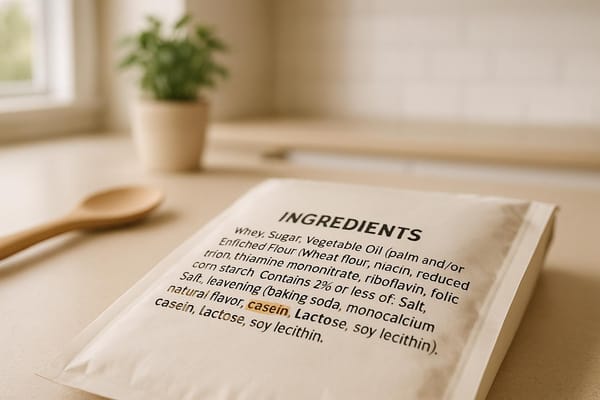Checklist for Finding Dairy-Free Food While Traveling
Stay dairy-free while traveling with practical tips on planning, packing, and communicating your dietary needs abroad.

Traveling with lactose intolerance can be tricky, but planning ahead makes it manageable. Here's a quick guide to staying dairy-free on the road:
- Research Before You Go: Locate grocery stores, markets, and restaurants with dairy-free options.
- Pack Essentials: Bring snacks like nuts, dried fruit, and dairy-free protein bars. Carry diet cards in the local language to explain your needs.
- Learn Key Phrases: Practice saying things like "Is this dairy-free?" in the local language.
- Double-Check Ingredients: Ask about oils, sauces, and toppings to avoid hidden dairy.
- Prepare for Emergencies: Pack enzyme supplements, antihistamines, and backup snacks.
With these steps, you can enjoy your trip without worrying about dairy!
3 Rules We ALWAYS Keep When Traveling Gluten Free and ...
Plan Your Food Options
Before traveling, take some time to look into grocery stores and markets at your destination that carry dairy-free products. This way, you’ll know where to find safe ingredients and avoid any last-minute stress.
Map Out Food Stores
Identify stores near where you’re staying that offer dairy-free options. Here are some types of places to keep in mind:
- Natural food stores with dairy-free sections
- Supermarkets with a selection of dairy-free alternatives
- Local markets with fresh produce
- Health food stores that carry specialty items
Save these locations in your phone's map app or download offline maps so you can easily find them, even without internet access. It’s also a good idea to call ahead and confirm they have what you need.
Pack Your Food Supplies
Once you've identified dining spots, make sure you're equipped with everything needed to stick to your dairy-free diet during the trip.
Stock Up on Dairy-Free Snacks
Pack some easy-to-carry, dairy-free snacks that won't spoil:
- Protein options: Nuts, seeds, beef jerky, or roasted chickpeas
- Fresh fruits: Apples, oranges, bananas
- Packaged snacks: Dairy-free protein bars, dried fruit, trail mix
- Shelf-stable choices: Dairy-free milk packets
These will keep you fueled and prepared for any unexpected delays or limited food options.
Create Diet Cards
Prepare cards in the local language that outline your dietary needs. Include:
- A clear explanation of your dairy-free diet
- A list of dairy ingredients to avoid
- Information about hidden dairy sources
- Notes on cross-contamination risks
- Emergency contact details
Keep both physical and digital copies of these cards handy. They can be a lifesaver when communicating your dietary restrictions.
Talk About Your Diet Needs
Clear communication is just as important as careful planning when it comes to making sure your dietary needs are met.
Learn Key Food Phrases
Here are a few phrases you might find helpful:
- "I cannot eat dairy products."
- "Does this contain milk, cheese, butter, or cream?"
- "Is this dish dairy-free?"
- "Can you prepare this without dairy?"
Save these phrases on your phone and practice them using native audio recordings if possible.
Double-Check Ingredients
When reviewing ingredients, ask specific questions to ensure the dish is dairy-free:
- Are there any dairy products in the oils, seasonings, or sauces used?
- Do you use separate utensils and surfaces to avoid cross-contamination?
- Are there any dairy toppings like cheese or cream added after cooking?
- Are the broths or sauces made with any dairy-based ingredients?
Request Menu Adjustments
Many restaurants are willing to adjust their dishes to suit your needs:
- Be clear and specific with your requests, such as asking for "grilled vegetables with olive oil." It’s often easier to communicate during less busy hours.
- Offer substitutions: Ask for avocado instead of cheese, or olive oil in place of butter.
- Show your appreciation by thanking the staff for accommodating your needs. A little gratitude goes a long way!
Handle Food Emergencies
Even with thorough preparation, finding dairy-free options might be challenging during emergencies. Here's how to stay ready for unexpected situations.
Pack Essential Items
Make sure you have the necessary supplies to manage accidental dairy exposure:
- Digestive Help: Carry milktab enzyme supplements (27,000 FCC units lactase) to help digest dairy if consumed by mistake.
- First Aid Supplies: Include antihistamines and any prescribed medications for dairy-related reactions. Keep them in a waterproof container and within easy reach, like in your carry-on.
- Medical Identification: Wear a medical alert bracelet or carry a card that explains your dietary restrictions in the local language.
Bring Backup Food
Pack shelf-stable, dairy-free snacks to avoid getting caught without safe options:
| Category | Examples | Storage Tips |
|---|---|---|
| Protein | Trail mix, jerky, protein bars | Use sealed containers |
| Snacks | Dried fruit, nuts, crackers | Add silica packets to reduce moisture |
| Meal Replacements | Instant oatmeal, soup packets | Keep in zip-lock bags |
These foods can be lifesavers when dairy-free meals aren’t available.
Plan for Medical Assistance
Prepare a list of key contacts and resources for emergencies:
- Local Healthcare: Research English-speaking doctors and hospitals at your destination.
- Emergency Numbers: Write down the local emergency service numbers (not all countries use 911).
- Travel Insurance: Keep your policy details and 24/7 assistance hotline handy.
- Embassy Info: Save the contact information and locations of the nearest embassy.
- Translation Tools: Download offline translation apps to explain your dietary needs clearly.
Conclusion
Traveling with dietary restrictions doesn’t have to be overwhelming. With a solid plan in place, you can explore new destinations while sticking to a dairy-free lifestyle.
For extra support, check out milktab, which offers lactase enzyme support (27,000 FCC units). One traveler shared their experience:
"Milktabs WORK!! I went on a European vacation and ate all the cheeses I wanted to! It was so great to have these tabs!!!!"
Here’s a quick breakdown of the key steps to help you stay on track:
| Focus Area | Key Actions | Benefits |
|---|---|---|
| Pre-Trip Planning | Research restaurants, map stores, learn phrases | Lowers stress and uncertainty |
| Essential Packing | Bring safe snacks, diet cards, emergency supplies | Ensures you're always prepared |
| On-Site Management | Communicate clearly, check ingredients, have backup options | Keeps your diet on track |
Each phase of your trip requires thoughtful preparation. By packing the right supplies, researching ahead, and staying adaptable, you can focus on enjoying your trip instead of worrying about food. With the right strategies, you’ll be ready for stress-free, memorable adventures.



